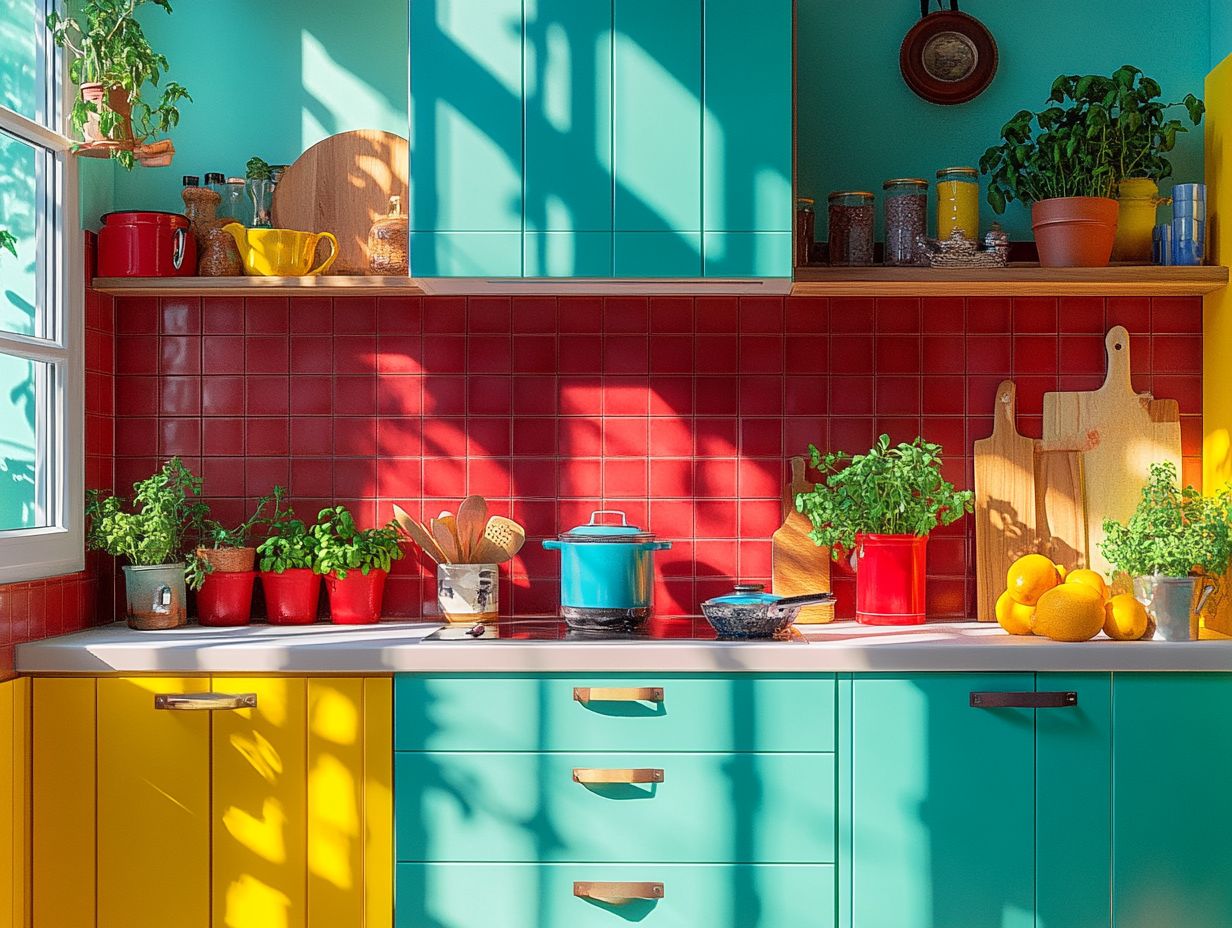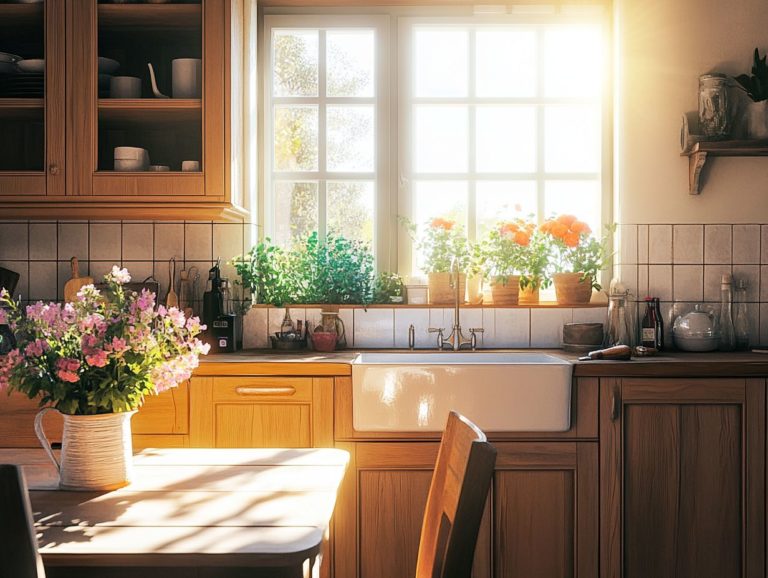5 Tips for a Colorful Kitchen Design
Transforming your kitchen into a vibrant space can be an exciting journey rather than a daunting task.
You’ll discover five straightforward yet impactful tips for incorporating color into your kitchen design. By starting with a neutral base and adding eye-catching accessories, you’ll master the essentials of creating a lively atmosphere.
Explore the best colors that resonate with your style, learn how to achieve balance in your design, identify common pitfalls to avoid, and uncover creative ideas tailored for small kitchens.
Get ready to bring your kitchen to life!
Contents
Key Takeaways:

Start with a neutral base to create a versatile and timeless look in your kitchen design.
Add pops of color with accessories like towels, rugs, and artwork to bring personality and vibrancy into your kitchen.
Incorporate colorful appliances for a functional and bold statement in your kitchen design.
1. Use a Neutral Base
A neutral base helps create a cohesive look and allows you to easily add vibrant colors. Soft hues like creamy white and light brown blend beautifully with natural wood elements.
This combination establishes an inviting atmosphere, perfect for family gatherings and cooking fun.
For instance, pairing deep navy cabinets with a creamy white backdrop achieves a striking contrast while maintaining a warm, welcoming feel.
Soft green or light brown can enrich the space, enhancing visual layering and depth.
These versatile base shades invite you to add vibrant accessories—think colorful dishware or lively wall art—ensuring that each element complements the overall design without overwhelming it.
2. Brighten Up with Fun Accessories!
Incorporating pops of color through accessories can truly transform a white kitchen into a vibrant space.
By introducing kitchen accessories like colorful canisters, bright dish towels, and striking cookware, you can cultivate an inviting and energetic atmosphere.
Textiles, like patterned table runners and cheerful window treatments, enhance comfort and unify different color palettes—from warm earth tones to lively jewel hues.
Thoughtfully selected artwork can serve as a captivating focal point, whether it’s a bold painting or playful wall decor.
Mastering the balance of these elements helps maintain a cohesive look that enhances the mood, ensuring your kitchen remains both functional and aesthetically pleasing.
3. Incorporate Colorful Appliances
Integrating colorful appliances into your kitchen design introduces unique elements to the space and reflects your personal style.
From bold reds and blues to gentle pastels, these appliances act as captivating statement pieces that catch the eye and spark conversation.
When selecting these hues, consider their harmony with cabinetry, countertops, and wall colors. Striking the right balance ensures that these vibrant shades enhance the overall aesthetic without overwhelming it.
For example, pairing a bright yellow toaster with muted cabinetry can establish a cheerful focal point while preserving a chic ambiance.
Thoughtful selection and placement are crucial for creating a beautifully integrated culinary space.
Try these tips today and watch your kitchen come alive!
4. Use Bold Patterns

Utilizing bold patterns in your backsplash tiles or other surfaces can infuse your kitchen design with energy, creating interesting layers that captivate and inspire your culinary creativity.
Whether you opt for a geometric mosaic or vivid botanical motifs, these elements not only draw the eye but also set the tone for the entire space.
For instance, a classic subway tile arranged in a herringbone pattern adds movement and depth, perfectly harmonizing with sleek cabinetry. On the other hand, a colorful tile with patterns can draw attention, playfully contrasting with more subdued countertops.
These design choices make your kitchen feel welcoming, encouraging gatherings and culinary adventures while still providing a sense of coherence when paired thoughtfully with complementary colors and finishes.
5. Don’t Be Afraid to Mix and Match Colors
Embracing the art of mixing and matching colors in your kitchen can lead to a dynamic design that showcases vibrant hues, crafting unique elements while ensuring a cohesive look throughout the space.
To create an inviting atmosphere, consider integrating warm neutrals like cream or beige, which serve as a grounding canvas for bolder colors. Adding colorful dishware or wall art can show off your personality without being too much.
A balanced approach involves varying the intensity of your colors; for instance, pairing a deep blue with soft pastels can help maintain harmony.
By thoughtfully selecting a mix of shades, you can transform your kitchen into a lively yet serene haven, where every color complements rather than clashes.
Why Should You Add Color to Your Kitchen Design?
Adding color to your kitchen design does more than just elevate the aesthetic; it transforms the space into an inviting haven, brimming with life and warmth that beckons family gatherings and culinary creativity.
How colors work together can really affect how you feel and spark your creativity, igniting sensations that lead to delightful culinary adventures.
For example, soft pastels like mint green or pale yellow create a tranquil backdrop, promoting calm and focus—ideal for family meal prep or casual gatherings. On the flip side, vibrant reds or oranges inject excitement and stimulation, perfect for coaxing the kids into the kitchen to lend a hand.
Whether you’re aiming for a sleek, modern look with cool blues and grays or a cozy, rustic ambiance with earthy tones, understanding how colors affect emotions gives you the power to design a kitchen that is not only visually stunning but also nurturing a sense of warmth and connection among family members.
What Are the Best Colors to Use in a Kitchen?
When selecting the best colors for your kitchen design, consider warm tones like creamy white or rich burgundy. These hues can create a welcoming environment while beautifully complementing modern aesthetics.
Along with these options, soft pastels such as mint green or pale blue can evoke a calming effect, making them ideal for a serene cooking space.
Darker shades like navy or forest green bring a touch of sophistication and can ground lighter cabinetry and surfaces, striking a stunning balance.
Successful designs often incorporate elements like contrasting accents, where a crisp white countertop pairs elegantly with deep blue cabinetry, creating visual interest without overwhelming your senses.
These choices not only ensure that your kitchen remains inviting and functional but also serve as a true reflection of your personality.
How Can You Balance Bold Colors in Your Kitchen?

Achieving balance with bold colors in your kitchen involves a thoughtful approach to layout and decorative accents, ensuring that those vibrant hues enhance rather than overpower the overall design.
To create this harmony, consider incorporating neutral elements like soft whites, grays, or beiges that serve as a calming backdrop. Textural contrasts are also essential; blending matte finishes with glossy accents can add visual interest without causing discord.
The strategic placement of decorative items—such as colorful dishware or artwork—can highlight focal points while allowing other areas to breathe.
By carefully selecting complementary colors and ensuring that each element aligns with a broader theme, you can maintain a cohesive look that celebrates boldness without sacrificing serenity.
What Are Some Common Mistakes to Avoid When Using Color in the Kitchen?
Common mistakes in color selection for kitchen design often arise from a lack of cohesiveness. This can result in spaces that feel chaotic and overwhelming instead of inviting and playful.
You might get carried away with bold colors, transforming your kitchen into a disjointed riot of hues that clash instead of harmonizing.
This often occurs when you choose an overly bold palette without considering how it interacts with adjacent elements like cabinetry, countertops, and the wall area behind your kitchen counter.
A better way to approach color is to limit your bold color choices to one or two. Use neutral tones to provide a grounding effect. For example, pairing a striking navy blue with soft whites can create a sophisticated yet warm environment.
Balance is essential; ensuring that your vibrant selections enhance rather than overshadow the overall design fosters an atmosphere that is both functional and aesthetically pleasing.
How Can You Create a Matching Color Scheme in Your Kitchen?
Creating a matching color scheme in your kitchen design involves carefully selecting colors that harmonize with warm neutrals and decorative accents. This will help craft a unified and inviting space.
Start with a palette of warm neutrals like soft beiges, taupes, and creamy whites. These can serve as a solid foundation for your kitchen, allowing other colors to shine without overwhelming your senses.
When selecting accent colors, think about incorporating earthy tones like terracotta or forest green. These shades resonate beautifully with wooden cabinetry or natural stone countertops.
You can also enhance your scheme with decorative accents, such as patterned tile on the wall behind your kitchen counter or colorful kitchen accessories.
For instance, imagine a kitchen with sandy beige cabinets complemented by deep navy accents. It creates a stunning yet serene environment. Alternatively, warm taupe walls paired with vibrant burnt orange decor can evoke a cheerful and inviting atmosphere, making the space truly your own.
What Are Some Creative Ways to Add Color to a Small Kitchen?
In a small kitchen, you can find creative ways to infuse color that will make the space feel larger and more inviting. Playful hues can act as focal points, enhancing the overall ambiance and setting a delightful tone.
One effective method is to incorporate vibrant soft goods, such as bright dish towels or patterned curtains. These small touches add splashes of color without overwhelming your senses.
Choosing wall paints in lively shades can energize the room, while using lighter colors on cabinetry and countertops ensures an airy atmosphere.
Accessories like colorful dishware or striking artwork serve as eye-catching details, drawing attention while keeping the space uncluttered.
By striking the right balance between bold and subtle tones, you can create a dynamic yet harmonious kitchen environment that feels both welcoming and stylish.
Frequently Asked Questions

Want to brighten up your kitchen?
Some easy ways to add color to your kitchen design are by incorporating colorful appliances, using fun dishware, painting an accent wall, adding colorful cabinet hardware, and using colorful backsplash tiles.
How can I create a matching color scheme in my kitchen?
To create a matching color scheme in your kitchen, choose a palette of 3-4 colors and incorporate them throughout the space. You can do this through paint, decor, and accessories.
What colors work best in kitchen design?
When choosing colors for a kitchen design, it’s important to consider the size and lighting of the space. Bright, bold colors like red, yellow, and green can add energy and warmth to a larger kitchen, while softer hues like blue and pastels can create a calming atmosphere in a smaller kitchen.
How can I add color without overwhelming my kitchen?
If you’re worried about adding too much color to your kitchen, start by incorporating it in small doses. Use colorful accents like towels, plants, or artwork, or choose a neutral color for your cabinets and add pops of color in the backsplash or countertop.
What are some current trends for colorful kitchen designs?
Bold colors like emerald green and navy blue are popular choices for kitchens. Unique patterns and textures, along with mixed colors and finishes, create an eclectic look that stands out.
Can I still have a colorful kitchen if I have a small budget?
Absolutely! You can add color without spending a lot. Try using vibrant peel-and-stick wallpaper, which is a simple way to transform your walls.
You can also refresh old furniture with a new coat of paint. Brighten up the space with colorful rugs, curtains, and dishware.





